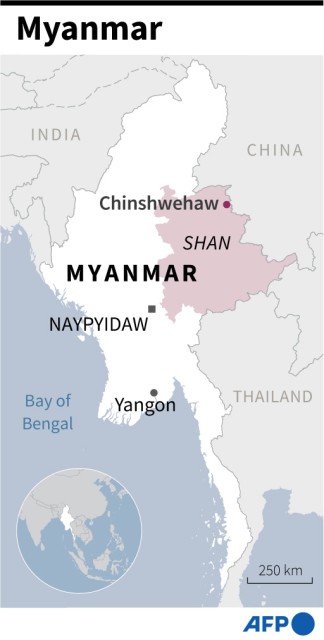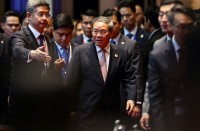
YANGON, Myanmar, Nov 3, 2023 (AFP) – An alliance of Myanmar ethnic minority groups said it made more gains in its offensive against the ruling junta on Friday, with the regime vowing it would hit back at the biggest military challenge it has faced since it seized power.
Fighting has raged for a week across a wide area of northern Shan state near the China border, forcing more than 23,000 people from their homes, according to the UN.
The Myanmar National Democratic Alliance Army (MNDAA), the Ta’ang National Liberation Army (TNLA) and the Arakan Army (AA) say they have captured dozens of outposts and four towns and blocked vital trade routes to China.
TNLA fighters seized an outpost from the military near the town of Namhkam near the China border on Friday, the group told AFP.
The military had called in air and artillery strikes, a TNLA spokesman said.
The MNDAA said on its media channel that its fighters had made gains in battles in the Kokang region, around 100 kilometres (60 miles) to the east.
A junta spokesman on Thursday dismissed as “propaganda” claims that the alliance had captured several towns in Shan state.
Junta chief Min Aung Hlaing said the military “will launch counter-attacks” against the groups, in comments carried by the state-run Global New Light of Myanmar newspaper on Friday.
A junta spokesman said on Wednesday that the military had lost control of Chinshwehaw town, a major trade hub on the border with China’s Yunnan province.
– Divided town –
A resident in Hsenwi, a strategic transport node around 90 kilometres (55 miles) from Chinshwehaw, told AFP that locals were hiding in their homes as clashes raged.
“It’s chaos — neither the military nor the alliance groups are in control of the town,” the resident told AFP by phone, requesting anonymity to protect their safety.
“There is fighting every day, with heavy artillery shelling and air strikes as well.”
He said an important bridge was down, effectively cutting the town in two, and people from outlying villages were moving in to seek shelter from clashes in the countryside.
“Thousands of people are stuck in town. We still have food to eat by sharing with each other,” he said, adding that 10 civilians had been killed and 10 wounded.
Communications with the remote region are patchy and access impossible while fighting rages, so AFP was unable to immediately confirm the casualty toll.
“Those who have knowledge of medicine are helping to treat the wounded — people dare not to go to the hospital although we heard it’s open,” the resident said.
Enze Han, an associate professor from the University of Hong Kong, told AFP that with the loss of Chinshwehaw and with other major roads to China blocked “at least currently… bilateral border trade between China (and) Myanmar has probably come to a stop.”
Trade amounted to more than $1.8 billion between April and September this year, state media reported in September, a crucial source of revenue for the junta.
– Trapped Thais –
Thailand said it had a plan to evacuate 162 of its citizens from Laukkai, a battle-scarred border town about 35 kilometres (22 miles) from Chinshwehaw, which the ethnic armed groups have hinted will be their next objective.
Fighting has been reported since the weekend around Laukkai, a key centre in a region rife with drugs, gun-running, prostitution and online scam centres.
Thai Foreign Minister Parnpree Bahiddha-Nukara said the 162 Thais were “safe under the guidance of the Myanmar government” and would be evacuated across the border to China if they wanted to leave the town.
China called on Thursday for an immediate ceasefire in Shan state — part of a planned billion-dollar rail route in its Belt and Road infrastructure project.
Myanmar’s borderlands are home to more than a dozen ethnic armed groups, some of which have fought the military for decades over autonomy and control of lucrative resources.
Some have trained and equipped newer “People’s Defence Forces” that have sprung up since the 2021 coup and the military’s bloody crackdown on dissent.
The AA, MNDAA and TNLA say the military has suffered dozens killed, wounded and captured since Friday.
The remoteness of the rugged, jungle-clad region — home to pipelines that supply oil and gas to China — and patchy communications make it difficult to verify casualty numbers in the fighting.







